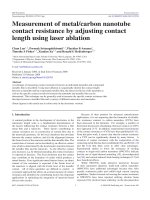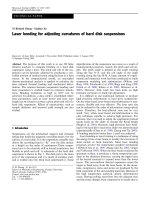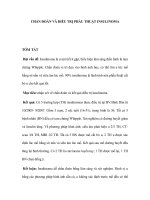adjusting insulin
Bạn đang xem bản rút gọn của tài liệu. Xem và tải ngay bản đầy đủ của tài liệu tại đây (206.6 KB, 22 trang )
International Diabetes Center
International Diabetes Center
Adjusting Insulin
International Diabetes Center
International Diabetes Center
Adjusting Insulin Using
Pattern Control
A process of
A process of
•
recognizing BG patterns
•
determining reasons why BG out of target
•
taking steps to bring BG back into target
To correct a pattern, you can change
To correct a pattern, you can change
•
food intake
•
activity
•
insulin
International Diabetes Center
International Diabetes Center
Self Management – Pattern Control
© 2003 International Diabetes Center. All rights reserved.
© 2003 International Diabetes Center. All rights reserved.
Monitor & Record
Monitor & Record
Monitor & Record
Monitor & Record
Assess
Assess
Influencing
Influencing
Factors
Factors
Assess
Assess
Influencing
Influencing
Factors
Factors
Evaluate Current
Evaluate Current
Dose
Dose
Evaluate Current
Evaluate Current
Dose
Dose
Identify Patterns
Identify Patterns
Identify Patterns
Identify Patterns
Take Action
Take Action
Take Action
Take Action
•
Consistency is
essential
•
% in target range
•
Frequency of
monitoring
•
Consistency is
essential
•
% in target range
•
Frequency of
monitoring
•
Consistency of
CHO
•
Timing of meals
•
Activity – Stress
•
Other medication
•
Consistency of
CHO
•
Timing of meals
•
Activity – Stress
•
Other medication
•
Assess units/kg
•
Insulin
distribution
by time of day
•
Assess units/kg
•
Insulin
distribution
by time of day
•
AM Fasting
•
Pre-meal
•
Post-meal with
rapid acting
Lows-2 days
Highs-3 days
•
AM Fasting
•
Pre-meal
•
Post-meal with
rapid acting
Lows-2 days
Highs-3 days
•
Insulin
•
Food
•
Activity
•
Insulin
•
Food
•
Activity
Pattern Control
Pattern Control
International Diabetes Center
International Diabetes Center
Record Blood Glucose Values
Date Breakfast Lunch Dinner Bedtime
8AM
BG
Med
BG
1 PM
BG
BG
7PM
BG
Med
BG
11PM
BG
Med
1/25
257
(14.3)
(14.3)
8R
16N
119
(6.6)
(6.6)
105
(5.8)
(5.8)
12R
14N
104
(5.8)
(5.8)
1/26
368
(20.4)
(20.4)
8R
16N
112
(6.2)
(6.2)
84
(4.7)
(4.7)
12R
14N
86
(4.8)
(4.8)
1/27
226
(12.6)
(12.6)
8R
16N
79
(4.4)
(4.4)
114
(6.3)
(6.3)
12R
14N
94
(5.2)
(5.2)
1/28
Pre-meal Target: 70-140 mg/dL (3.9-7.8 mmol/L)
(mmol/L)
Treat to Target
HbA1c
HbA1c
< 7%
< 7%
Fasting and Pre meal glucose
Fasting and Pre meal glucose
70-140 mg/dL (3.9-7.8 mmol/L)
70-140 mg/dL (3.9-7.8 mmol/L)
Postprandial glucose
Postprandial glucose
<160 mg/dL (8.8 mmol/L)
<160 mg/dL (8.8 mmol/L)
(
(
Two hours after the start of a meal the BG should
Two hours after the start of a meal the BG should
be no more than 20 to 40 mg/dL or 1.1 to 2.2 mmol/L
be no more than 20 to 40 mg/dL or 1.1 to 2.2 mmol/L
above the pre-meal BG
above the pre-meal BG
)
)
Bedtime glucose
Bedtime glucose
100-160 mg/dL (5.5-8.9 mmol/L)
100-160 mg/dL (5.5-8.9 mmol/L)
International Diabetes Center
International Diabetes Center
International Diabetes Center
International Diabetes Center
Testing Frequency
Patients on Insulin
•
Four times/day recommended
Four times/day recommended
•
Testing before each meal and before bedtime
Testing before each meal and before bedtime
•
May also test pre-meal and 2 hours post meal to evaluate effect of
May also test pre-meal and 2 hours post meal to evaluate effect of
insulin on post-meal glucose
insulin on post-meal glucose
•
Modify frequency of monitoring if necessary
Modify frequency of monitoring if necessary
•
Encourage patients to record values in a record book
Encourage patients to record values in a record book
International Diabetes Center
International Diabetes Center
RA
RA
RA
Times to Test Blood Glucose
Serum insulin (mU/L)
Hours
RA
RA
RA
Glargine
Glargine
0
10
20
30
40
50
0 2 4 6 8 10 12 14 16 18 20 22 24
SMBG
SMBG
SMBG
SMBG
SMBG
SMBGSMBG
SMBG
Meal
Meal
Meal
Meal
Meal
Meal
International Diabetes Center
International Diabetes Center
Testing Guidelines
Lispro (Humalog) or Aspart (Novolog)
Test
Test
before
before
meal and two hours
meal and two hours
after
after
meal
meal
•
compare the before and after meal glucose
compare the before and after meal glucose
•
adjust
adjust
Lispro or Aspart
Lispro or Aspart
insulin if
insulin if
difference > 40 mg/dL (2.2 mmol/L)
difference > 40 mg/dL (2.2 mmol/L)
•
adjust basal insulin if fasting or
adjust basal insulin if fasting or
pre-evening meal glucoses out of target
pre-evening meal glucoses out of target
International Diabetes Center
International Diabetes Center
Self Management – Pattern Control
© 2004 International Diabetes Center. All rights reserved.
© 2004 International Diabetes Center. All rights reserved.
Pattern Control
Pattern Control
Monitor & Record
Monitor & Record
Monitor & Record
Monitor & Record
Assess
Assess
Influencing
Influencing
Factors
Factors
Assess
Assess
Influencing
Influencing
Factors
Factors
Evaluate Current
Evaluate Current
Dose
Dose
Evaluate Current
Evaluate Current
Dose
Dose
Identify Patterns
Identify Patterns
Identify Patterns
Identify Patterns
Take Action
Take Action
Take Action
Take Action
•
Consistency is
essential
•
% in target range
•
Frequency of
monitoring
•
Consistency is
essential
•
% in target range
•
Frequency of
monitoring
•
Consistency of
CHO
•
Timing of meals
•
Activity – Stress
•
Other medication
•
Consistency of
CHO
•
Timing of meals
•
Activity – Stress
•
Other medication
•
Insulin
distribution
by time of day
•
Assess units/kg
•
Insulin
distribution
by time of day
•
Assess units/kg
•
AM Fasting
•
Pre-meal
•
Post-meal with
rapid acting
Lows-2 days
Highs-3 days
•
AM Fasting
•
Pre-meal
•
Post-meal with
rapid acting
Lows-2 days
Highs-3 days
•
Insulin
•
Food
•
Activity
•
Insulin
•
Food
•
Activity
International Diabetes Center
International Diabetes Center
Assessing Influencing Factors
•
Carbohydrate content of meals
Carbohydrate content of meals
–
Counting correctly
–
Consistency
•
Timing of meals and snacks
Timing of meals and snacks
–
Delayed meals and skipped snacks can cause hypoglycemia with conventional regimens
–
Delayed basal insulin can increase blood glucose
International Diabetes Center
International Diabetes Center
Assessing Influencing Factors
•
Increase in exercise
Increase in exercise
–
In type 2 diabetes, exercise lowers BG and decreases insulin resistance
•
Illness and Stress
Illness and Stress
–
Blood glucose usually increases
•
Steroids
Steroids
–
Increases blood glucose
International Diabetes Center
International Diabetes Center
Self Management – Pattern Control
© 2004 International Diabetes Center. All rights reserved.
© 2004 International Diabetes Center. All rights reserved.
Pattern Control
Pattern Control
Monitor & Record
Monitor & Record
Monitor & Record
Monitor & Record
Assess
Assess
Influencing
Influencing
Factors
Factors
Assess
Assess
Influencing
Influencing
Factors
Factors
Evaluate Current
Evaluate Current
Dose
Dose
Evaluate Current
Evaluate Current
Dose
Dose
Identify Patterns
Identify Patterns
Identify Patterns
Identify Patterns
Take Action
Take Action
Take Action
Take Action
•
Consistency is
essential
•
% in target range
•
Frequency of
monitoring
•
Consistency is
essential
•
% in target range
•
Frequency of
monitoring
•
Consistency of
CHO
•
Timing of meals
•
Activity – Stress
•
Other medication
•
Consistency of
CHO
•
Timing of meals
•
Activity – Stress
•
Other medication
•
Assess units/kg
•
Insulin
distribution
by time of day
•
Assess units/kg
•
Insulin
distribution
by time of day
•
AM Fasting
•
Pre-meal
•
Post-meal with
rapid acting
Lows-2 days
Highs-3 days
•
AM Fasting
•
Pre-meal
•
Post-meal with
rapid acting
Lows-2 days
Highs-3 days
•
Insulin
•
Food
•
Activity
•
Insulin
•
Food
•
Activity
International Diabetes Center
International Diabetes Center
Evaluate Current Insulin Dose
Assess if overinsulinization
•
Calculate the current total daily insulin in units/kg
Calculate the current total daily insulin in units/kg
Average total insulin/day:
Type 1- 0.7 units/kg
Type 2 – 1 unit/kg
•
Bolus : basal distribution is usually 50:50
Bolus : basal distribution is usually 50:50
Remember:
Remember:
•
consistent exercise needs less basal insulin
consistent exercise needs less basal insulin
•
consistent high carbohydrate intake needs more bolus insulin
consistent high carbohydrate intake needs more bolus insulin
International Diabetes Center
International Diabetes Center
Self Management – Pattern Control
© 2004 International Diabetes Center. All rights reserved.
© 2004 International Diabetes Center. All rights reserved.
Pattern Control
Pattern Control
Monitor & Record
Monitor & Record
Monitor & Record
Monitor & Record
Assess
Assess
Influencing
Influencing
Factors
Factors
Assess
Assess
Influencing
Influencing
Factors
Factors
Evaluate Current
Evaluate Current
Dose
Dose
Evaluate Current
Evaluate Current
Dose
Dose
Identify Patterns
Identify Patterns
Identify Patterns
Identify Patterns
Take Action
Take Action
Take Action
Take Action
•
Consistency is
essential
•
% in target range
•
Frequency of
monitoring
•
Consistency is
essential
•
% in target range
•
Frequency of
monitoring
•
Consistency of
CHO
•
Timing of meals
•
Activity – Stress
•
Other medication
•
Consistency of
CHO
•
Timing of meals
•
Activity – Stress
•
Other medication
•
Assess units/kg
•
Insulin
distribution
by time of day
•
Assess units/kg
•
Insulin
distribution
by time of day
•
AM Fasting
•
Pre-meal
•
Post-meal with
rapid acting
Lows-2 days
Highs-3 days
•
AM Fasting
•
Pre-meal
•
Post-meal with
rapid acting
Lows-2 days
Highs-3 days
•
Insulin
•
Food
•
Activity
•
Insulin
•
Food
•
Activity
International Diabetes Center
International Diabetes Center
Date Breakfast Lunch Supper Bedtime
Notes
BG
BG
After
meal
BG
BG
After
meal
BG
BG
After
meal
BG
10/13
140
(7.8)
(7.8)
136
(7.6)
(7.6)
186
(10.3)
(10.3)
10/14
138
(7.6)
(7.6)
126
(7.0)
(7.0)
206
(11.4)
(11.4)
10/15
101
(5.6)
(5.6)
135
(7.5)
(7.5)
197
(10.9)
(10.9)
10/16
158
(8.8)
(8.8)
128
(7.1)
(7.1)
239
(13.3)
(13.3)
View Patterns
•
View columns vertically - same time each day
•
Highlight values outside of target range
•
Target: 70-120 mg/dL (3.9-6.7 mmol/L)
(mmol/L)
International Diabetes Center
International Diabetes Center
Guidelines for Insulin Adjustment
Current Dose
Current Dose
Pattern of Lows
Pattern of Lows
Pattern of Highs
Pattern of Highs
10 units or less
10 units or less
Decrease by 1 unit
Decrease by 1 unit
Increase by 1 unit
Increase by 1 unit
More than 10 units
More than 10 units
Decrease by 2 units Increase by 2 units
Decrease by 2 units Increase by 2 units
or 10%
or 10%
or 10%
or 10%
International Diabetes Center
International Diabetes Center
Date Breakfast Lunch Supper Bedtime Note
BG
Med
BG
Med
BG
Med
BG
Med
10/15
98
(5.4)
(5.4)
12 R
24 N
106
(5.9)
(5.9)
138
(7.7)
(7.7)
10 R
138
(7.7)
(7.7)
10/16
103
(5.7)
(5.7)
62
(3.4)
(3.4)
299
(16.7)
(16.7)
143
(7.9)
(7.9)
10/17
84
(4.7)
(4.7)
53
(2.9)
(2.9)
342
(19.0)
(19.0)
243
(13.5)
(13.5)
10/18
89
(4.9)
(4.9)
First, address low blood glucose values
Adjust if below target two days in a row
Ignore highs following lows for 8-12 hrs
10N
(mmol/L)
International Diabetes Center
International Diabetes Center
Address BG values if above target 3 consecutive days
Change only one type of insulin and one dose at a time
Date Breakfast Lunch Ev. Meal Bedtime Note
BG
Med
BG
Med
BG
Med
BG
Med
10/15
142
(7.9)
(7.9)
Met
1000
126
(7.0)
(7.0)
138
(7.7)
(7.7)
Met
1000
138
(7.7)
(7.7)
10 G
10/16
194
(10.8)
(10.8)
162
(9.0)
(9.0)
144
(8.0)
(8.0)
143
(7.9)
(7.9)
10/17
163
(9.1)
(9.1)
153
(8.5)
(8.5)
131
(7.3)
(7.3)
243
(13.5)
(13.5)
10/18
262
(14.6)
(14.6)
(mmol/L)
International Diabetes Center
International Diabetes Center
50 y.o. male
Eats 3 meals/day; no snacks
Target 70-120mg/dl (3.9 – 6.7 mmol/L)
Wt: 75 kg (165 lb)
HbA1c: 7.6%
Adjusting Physiologic Insulin
Stage 4
Breakfast Lunch Ev. Meal Bedtime Notes
Date 3am
BG
BG Med BG BG Med BG BG Med BG BG Med
10/5 96
(5.3)
(5.3)
12
RA
213
(11.8)
(11.8)
14
RA
134
(7.4)
(7.4)
12
RA
187
(10.4)
(10.4)
38G
10/6 87
(4.8)
(4.8)
12
RA
174
(9.7)
(9.7)
14
RA
122
(6.8)
(6.8)
12
RA
205
(11.4)
(11.4)
38G
10/7 70
(3.9)
(3.9)
12
RA
199
(11.1)
(11.1)
14
RA
87
(4.8)
(4.8)
12
RA
193
(10.7)
(10.7)
38G
(mmol/L)
International Diabetes Center
International Diabetes Center
Self Management – Pattern Control
© 2004 International Diabetes Center. All rights reserved.
© 2004 International Diabetes Center. All rights reserved.
Monitor & Record
Monitor & Record
Monitor & Record
Monitor & Record
Assess
Assess
Influencing
Influencing
Factors
Factors
Assess
Assess
Influencing
Influencing
Factors
Factors
Evaluate Current
Evaluate Current
Dose
Dose
Evaluate Current
Evaluate Current
Dose
Dose
Identify Patterns
Identify Patterns
Identify Patterns
Identify Patterns
Take Action
Take Action
Take Action
Take Action
•
Consistency is
essential
•
% in target range
•
Frequency of
monitoring
•
Consistency is
essential
•
% in target range
•
Frequency of
monitoring
•
Consistency of
CHO
•
Timing of meals
•
Activity – Stress
•
Other medication
•
Consistency of
CHO
•
Timing of meals
•
Activity – Stress
•
Other medication
•
Assess units/kg
•
Insulin
distribution
by time of day
•
Assess units/kg
•
Insulin
distribution
by time of day
•
AM Fasting
•
Pre-meal
•
Post-meal with
rapid acting
Lows-2 days
Highs-3 days
•
AM Fasting
•
Pre-meal
•
Post-meal with
rapid acting
Lows-2 days
Highs-3 days
•
Insulin
•
Food
•
Activity
•
Insulin
•
Food
•
Activity
Pattern Control
Pattern Control
International Diabetes Center
International Diabetes Center
Changing from Conventional to Physiologic
Insulin Therapy Using Glargine
•
Total all daily insulin and then subtract 20% =
Total all daily insulin and then subtract 20% =
New total daily insulin
New total daily insulin
•
New total daily insulin dose split 50% bolus at meals
New total daily insulin dose split 50% bolus at meals
(RA or Regular) and 50% Glargine
(RA or Regular) and 50% Glargine
Example:
Example:
Current Insulin Dose: 5 RA/12 N & 6RA/8N = 33 units/day
Current Insulin Dose: 5 RA/12 N & 6RA/8N = 33 units/day
New Insulin Dose: 33 units – 20% = 26 units/day
New Insulin Dose: 33 units – 20% = 26 units/day
4 RA – 4 RA – 4 RA – 13 G
4 RA – 4 RA – 4 RA – 13 G
International Diabetes Center
International Diabetes Center
Changing from Conventional to
Physiologic Insulin Therapy
Comparison
Current recommended:
Current recommended:
36 units total N minus 20% = 29 units of glargine
36 units total N minus 20% = 29 units of glargine
New regimen: 3RA – 3RA – 3RA – 29 G
New regimen: 3RA – 3RA – 3RA – 29 G
SDM:
SDM:
Total daily dose 46 units minus 20% = 37 units/day
Total daily dose 46 units minus 20% = 37 units/day
50% basal – 50% bolus
50% basal – 50% bolus
New regimen: 6 RA – 6RA – 6RA – 18 G
New regimen: 6 RA – 6RA – 6RA – 18 G
Current Insulin: AM 6RA/20 N PM 4RA/16 N
Current Insulin: AM 6RA/20 N PM 4RA/16 N
Current Insulin: AM 6RA/20 N PM 4RA/16 N
Current Insulin: AM 6RA/20 N PM 4RA/16 N









